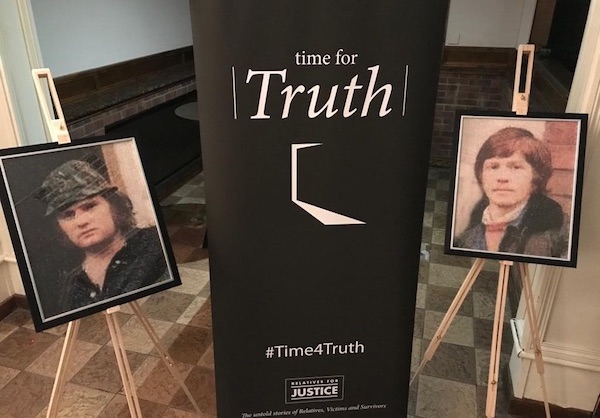
Relatives for Justice have launched a report into the killings of Jim Bryson and Patrick Mulvenna amid outstanding questions about the shoot-to-kill policy of targeted state assassinations which was responsible for their deaths.
Volunteers Jim Bryson and Patrick Mulvenna were ambushed by the British Army as they drove through Ballymurphy on 31 August 1973. Mulvenna died instantly while his friend and comrade Jim Bryson succumbed to his wounds three weeks later, dying on 22 September.
The men were feared by the British Army because of their courage and military prowess and it was no surprise that the British Army decided to summarily execute them.
Sinn Fein’s Gerry Kelly, Patrick Mulvenna’s cousin, has described the two men as “leaders of the struggle who led with courage and imagination”.
The families, supported by RFJ, believe that the two men were victims of a shoot-to-kill policy carried out by the British state.
The evidence contained in the new report supports this view. This includes the level of British Army impunity from potential court proceedings, two previous occasions when the British Army appeared to target Jim Bryson, and the fact that their vehicle was shot at from behind.
The shooting was in contravention of, at the time, the British Army’s “Yellow Card” procedures.
The families and Relatives For Justice are aware of the identity of the soldier who fired the shots, who was serving in the Royal Green Jackets and was decorated for his actions.
The report highlights the “light touch” investigations carried out by the Royal Military Police, an inquest and an Historical Enquiries Team (HET) report. All these investigations were deeply flawed and got nowhere near the truth.
In a statement, Relatives for Justice said the two families were seeking accountability and legal redress from the British state and Ministry of Defence for their loss.
“There was never a proper independent investigation into Jim and Patrick’s killings,” they said.
“They want to know the truth about what happened to Patrick and Jim rather than the constructed false narrative that was and is promoted by elements of the British state. The families deserve no less.”
PATSY DUFFY REMEMBERED
Meanwhile, a series of events took place in Derry last weekend to mark the 40th anniversary of what is believed to be the very first British army shoot-to-kill operation in the north of Ireland.
Following the 1978 killing of unarmed IRA member Patsy Duffy, the then bishop of Derry Edward Daly accused the British Army of carrying out a shoot-to-kill operation, the first time the phrase was used in an Irish context.
The father-of-eight was shot dead by undercover British soldiers on November 24 1978 when he went to check on IRA arms in a house at Maureen Avenue in Derry’s Abercorn Road area.
Although unarmed at the time the 50 year-old was shot 14 times while his daughter and grandchild waited in a car outside.
Mr Duffy’s family believe he was killed by an SAS unit.
A mural in his honour was unveiled last Saturday by the 32 County Sovereignty Movement at Brandywell Road while a wreath laying ceremony led by the organisation and his family took place at his grave on Sunday. tomorrow.
The anniversary was also marked by Sinn Fein with a commemoration at the Republican Monument at Lecky Road on Saturday.
![[Irish Republican News]](https://republican-news.org/graphics/title_gifs/rn.gif)
![[Irish Republican News]](https://republican-news.org/graphics/title_gifs/harp.gif)

